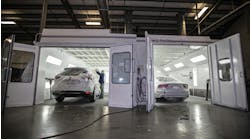In a world that is continually changing and evolving, it seems that if you don’t get with the modern era, it will pass you by before you even realize it. Tomorrow’s iPhone 6 is yesterday’s iPhone 5. Technology is advancing at a rate that most have a hard time comprehending, which for us runs parallel to the equipment and development of newer vehicles and repair processes.
With these modern times comes new ideas in paint technology. If you take a moment and do a search for the process of making the new Lexus color Structural Blue, it’s quite fascinating to say the least. We are seeing more translucent colors coming available, more chromatic colors becoming available and quad sage colors coming from the factory, with no slowing down in sight. Yet, for some reason we have a collision repair industry that holds back and is reluctant to change. All over what can be quite simply the easiest thing they will do — converting from solvent to water. Why is that? Let’s talk about.
For many shop owners and even painters, it seems that they are hellbent on holding onto solvent for their collision work. With excuses such as “there’s nothing wrong with it;” “I don’t have any paint issues;” or “I don’t want to slow down waiting for it to dry,” tends to sound much like the same thing heard by the previous generation when the introduction of basecoat/clearcoat systems came into the market and the old days of lacquer and enamel were being phased out. Most times the biggest issue tends to be not the swap itself, but education about the differences and actually understanding of the advantages of a water system.
About 10 years ago, most of the OEMs had made the transition to water and vehicles in production were now coming with waterborne paint jobs. Those still spraying solvent began to start having more issues in matching the colors (myself included here!) Waterborne can give a lot cleaner, more vibrant color than the solvents. I remember having a hard time working some of the solid blacks from Toyota because the newer water version of the color tended to have a brown cast on the side. Many of the colors I came across were becoming harder to match in solvent, but the one thing I had continually heard was about the color match being so much better in water. And it wasn’t just in the line I was spraying, I was hearing that from users of all paint lines. The color match tools available today in the water systems are far superior to what was/is available in solvent lines today. For the longest time the deck of color chips seemed to be a waste as it was a representation of the color and not an actual spray out. Or the color that was sprayed out for one line was actually another line. As absurd as that sounds, it was a not-so-quiet secret that many paint reps would tell you. The spectrophotometers are more adapted to water technology and are being updated and fine-tuned each year for helping in color match. As with anything, these are TOOLS and not a crutch, folks. Know your basics first, and use the tools provided to add value to your worth.
So here’s the skinny. For those of you who are holdouts for the reasons listed earlier, let’s look at what is actually needed in order to swap successfully to water. First is the understanding of humidity and temperature. You no longer are looking solely at the temperature of the panel for a reducer selection. Now you’re mainly looking at the humidity levels in the booth and basing your reduction on that. “But how am I going to get water to dry if it’s humid?” you may be asking. AIR MOVEMENT. Waterborne paints are dried by air movement, plain and simple. The more air you can get moving, the better for flash times. Many spray gun companies offer several styles of blowers, both fan style and dryer style. I personally have found the dryer style blowers move more volume of air and tend to do the trick pretty fast. Some booth manufacturers also have fans that attach to the ceiling with variable speed that can seriously get the air moving more. Something to keep in the back of your mind is the amount of air volume that is needed for these blower setups and how quickly they can drain an air compressor and find the flaws in a system. There are all sorts of mounting options for fixed blowers and fans out there that all you have to do is look. You can add the ceiling fans with adjustable speeds, add the stands with blowers on them, or stand there with a blower in hand, but the air needs to be flowing, and it needs to be clean.
Speaking of clean air, let’s talk filtration. We all know the benefits of clean air, yet there are still shops that run a cheap water/oil filter and call it good. This is a whole different topic with painter safety and the need for Grade D breathable air in the booth, but that I’ll save for another day. Yet, filtration can be the most commonly overlooked setup in a paint shop when trying to diagnose a problem. By ensuring good, clean air with a quality 3 stage filtration unit, you are insuring that nothing is going to be contaminating the waterborne system. Not only should you have proper filtration in place, but the filters should be changed on a regular basis. I have come across many shop owners who actually believe that since the filter is in place, it will continually do its job and should be changed once a year. That’s not a misprint — that is something I have actually seen and heard with my own eyes and ears. Let’s all think back to 5th grade science class now, water and oil…..they don’t mix.
One of the biggest things that I’ve heard first-hand about why some shops won’t switch is actually such a small piece of the puzzle. Yet, it’s one of the most important, and that is training. For many shops, it seems to be the old-school mentality of just going in the booth and pulling the trigger that has worked for years. The difference is with water, there are other factors to take into consideration rather than walking into the booth. Water is a whole different animal. Yet most painters, when trained on the basics of mixing and application, can make the transition with minimal speed bumps. I personally found the transition to water in the collision environment to be much easier than expected, and in all honesty, easier than swapping paint lines for another solvent line. The main thing to understand here is that application is key. Just like any other paint, if you don’t understand how it’s meant to be used and the tricks with it, you can have a very bad day rather quickly. Being trained by the paint manufacturer on their system is crucial to your success in the transition. Most techs that I have spoken with find that the only issue in application that they have is just getting in the mindset that you are spraying something different from what they had sprayed before. It became repetition for one painter I spoke with as he would say, “I just had to remind myself as I walked in the booth with my gun that it’s water, it’s water, it’s water.” Of course like with anything, systems are designed much different from each other with many varying application techniques. Find a system that works for you and capitalize on the training available.
At the end of the day, making the swap isn’t horrible. Know that going in, it’s going to be a strange feeling swapping to something completely new. Know that it will be different. Know that with training and a few days, it’s going to be much simpler than you think. And know at the end of the day, you’re going to be able to match colors quicker, have faster cycle times, and up production, which in turn puts more money in your pocket.




